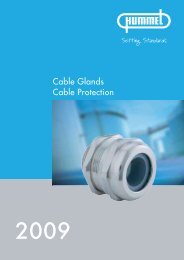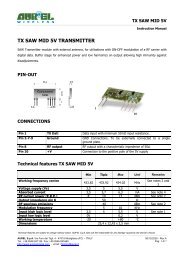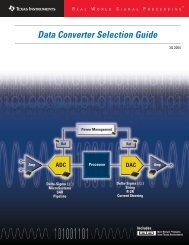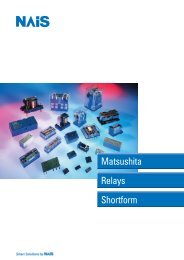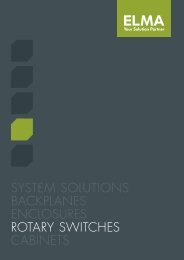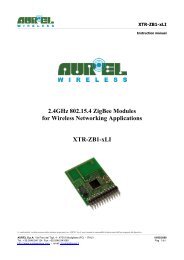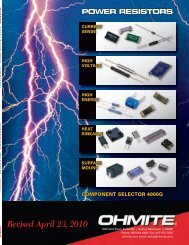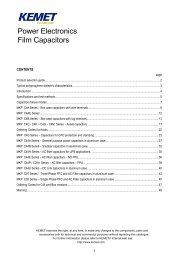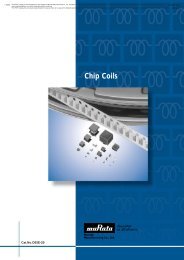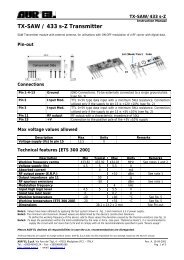On-Board Type (DC) EMI Suppression Filters (EMIFILr)
On-Board Type (DC) EMI Suppression Filters ("EMIFIL")
On-Board Type (DC) EMI Suppression Filters ("EMIFIL")
- No tags were found...
You also want an ePaper? Increase the reach of your titles
YUMPU automatically turns print PDFs into web optimized ePapers that Google loves.
!Note • This !Note PDF catalog • Please is downloaded read rating and from !CAUTION the website (for of Murata storage, Manufacturing operating, rating, co., ltd. soldering, Therefore, mounting it’s specifications and handling) are in subject this catalog to change to prevent or our smoking products and/or in it may burning, be discontinued etc. without advance notice. Please check with our<br />
sales representatives • This catalog or product has only engineers typical specifications before ordering. because there is no space for detailed specifications. Therefore, please approve our product specifications or transact the approval sheet for product specifications before ordering.<br />
• This PDF catalog has only typical specifications because there is no space for detailed specifications. Therefore, please approve our product specifications or transact the approval sheet for product specifications before ordering.<br />
C31E.pdf<br />
08.9.1<br />
Lead <strong>Type</strong> <strong>EMI</strong>FILr (Soldering and Mounting)<br />
Continued from the preceding page.<br />
3. Using <strong>EMI</strong>GUARDr effectively<br />
(1) Terminal (with mark) should be properly connected to<br />
the line of incoming electrostatic surge. (There is<br />
polarity.) Otherwise, no effect in ESD suppression can<br />
be expected (VFR3V).<br />
(2) Products should be used at rated voltage or less and<br />
rated current or less.<br />
(3) Products should not be applied for the absorption of<br />
surges which have large energy (ex. induced lightning<br />
surges, switching surges) because it is designed for the<br />
absorption of electrostatic surges (VFR3V).<br />
(4) Electrostatic test should be done on the following<br />
conditions (VFR3V).<br />
n • [ C / R • V 2 ] 2 < 8.0 ×10 5<br />
n: Times applied<br />
C: Charging Capacitance (pF)<br />
V: Testing Voltage (kV)<br />
R: Charging Resistance (Ω)<br />
Example of input terminal<br />
incoming<br />
Electrostatic Surges<br />
Example of output terminal<br />
incoming<br />
Electrostatic Surges<br />
4. Soldering<br />
(1) Solder: H60A, H63A solder (JIS Z 3238)<br />
In case of lead-free solder, use Sn-3.0Ag-0.5Cu solder.<br />
(2) Use Rosin-based flux. Do not use strong acidic flux with<br />
halide content exceeding 0.2wt% (chlorine conversion<br />
value).<br />
(3) Products and the leads should not be subjected to any<br />
mechanical stress during the soldering process, or while<br />
subjected to the equivalent high temperatures.<br />
(4) Standard flow soldering profile<br />
Temperature (°C)<br />
300<br />
250<br />
200<br />
150<br />
100<br />
50<br />
Pre-heating<br />
150°C<br />
60s min.<br />
Gradual cooling<br />
Soldering<br />
(in air)<br />
Soldering temperature<br />
Soldering time<br />
Solder Soldering temperature Soldering time<br />
Sn/Pb=60/40, Sn/Pb=63/37<br />
Sn-3.0Ag-0.5Cu solder<br />
240 to 260˚C<br />
250 to 260˚C<br />
5s max.<br />
4 to 6s<br />
6<br />
5. Cleaning Conditions<br />
Do not clean VFR3V, PLT09H and VFS6V series.<br />
Clean other parts in the following conditions.<br />
(1) Cleaning temperature should be limited to 60°C max.<br />
(40°C max for alcohol type cleaner).<br />
(2) Ultrasonic cleaning should comply with the following<br />
conditions, avoiding the resonance phenomenon at the<br />
mounted products and P.C.B.<br />
Power: 20 W / l max. Frequency: 28 to 40kHz<br />
Time: 5 min. max.<br />
(3) Cleaner<br />
(a) Alcohol type cleaner<br />
Isopropyl alcohol (IPA)<br />
(b) Aqueous agent (PLT series cannot be cleaned)<br />
PINE ALPHA ST-100S<br />
(4) There should be no residual flux or residual cleaner left<br />
after cleaning.<br />
In the case of using aqueous agent, products should be<br />
dried completely after rinsing with de-ionized water in<br />
order to remove the cleaner.<br />
(5) The surface of products may become dirty after cleaning,<br />
but there is no deterioration on mechanical, electrical<br />
characteristics and reliability.<br />
(6) Other cleaning: Please contact us.<br />
190 3



